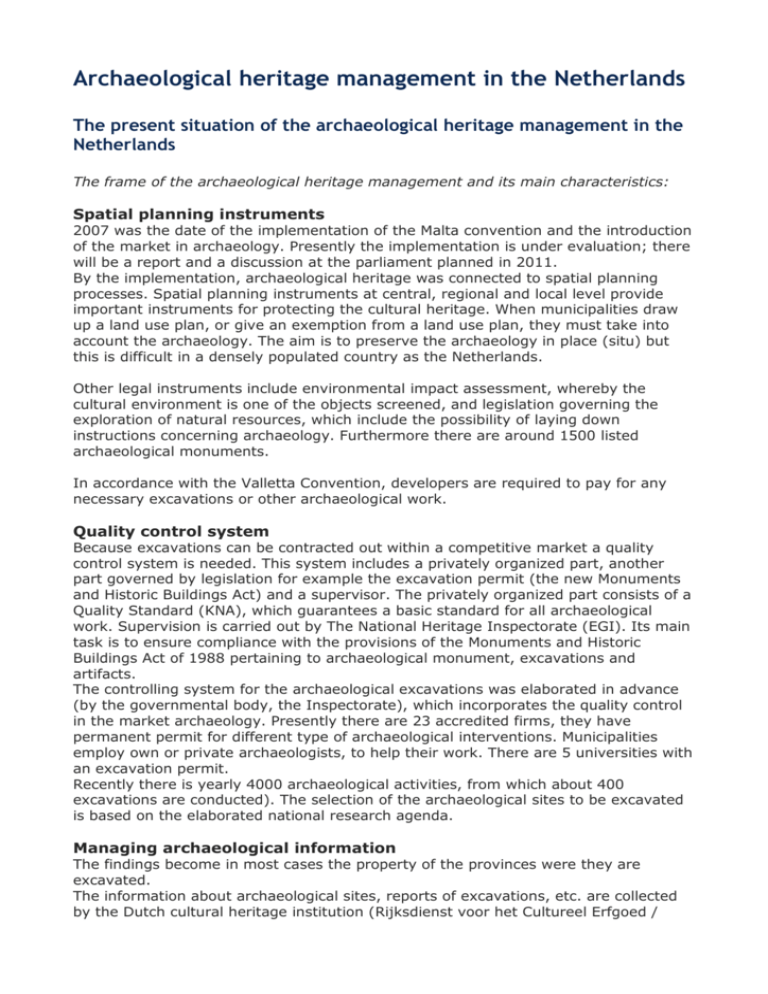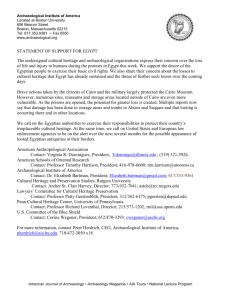Archaeological heritage management in the Netherlands
advertisement

Archaeological heritage management in the Netherlands The present situation of the archaeological heritage management in the Netherlands The frame of the archaeological heritage management and its main characteristics: Spatial planning instruments 2007 was the date of the implementation of the Malta convention and the introduction of the market in archaeology. Presently the implementation is under evaluation; there will be a report and a discussion at the parliament planned in 2011. By the implementation, archaeological heritage was connected to spatial planning processes. Spatial planning instruments at central, regional and local level provide important instruments for protecting the cultural heritage. When municipalities draw up a land use plan, or give an exemption from a land use plan, they must take into account the archaeology. The aim is to preserve the archaeology in place (situ) but this is difficult in a densely populated country as the Netherlands. Other legal instruments include environmental impact assessment, whereby the cultural environment is one of the objects screened, and legislation governing the exploration of natural resources, which include the possibility of laying down instructions concerning archaeology. Furthermore there are around 1500 listed archaeological monuments. In accordance with the Valletta Convention, developers are required to pay for any necessary excavations or other archaeological work. Quality control system Because excavations can be contracted out within a competitive market a quality control system is needed. This system includes a privately organized part, another part governed by legislation for example the excavation permit (the new Monuments and Historic Buildings Act) and a supervisor. The privately organized part consists of a Quality Standard (KNA), which guarantees a basic standard for all archaeological work. Supervision is carried out by The National Heritage Inspectorate (EGI). Its main task is to ensure compliance with the provisions of the Monuments and Historic Buildings Act of 1988 pertaining to archaeological monument, excavations and artifacts. The controlling system for the archaeological excavations was elaborated in advance (by the governmental body, the Inspectorate), which incorporates the quality control in the market archaeology. Presently there are 23 accredited firms, they have permanent permit for different type of archaeological interventions. Municipalities employ own or private archaeologists, to help their work. There are 5 universities with an excavation permit. Recently there is yearly 4000 archaeological activities, from which about 400 excavations are conducted). The selection of the archaeological sites to be excavated is based on the elaborated national research agenda. Managing archaeological information The findings become in most cases the property of the provinces were they are excavated. The information about archaeological sites, reports of excavations, etc. are collected by the Dutch cultural heritage institution (Rijksdienst voor het Cultureel Erfgoed / Cultural Heritage Agency – RCE, they have 300 employees), which is the successor of ROB, then RACM. The institution is responsible for monuments, archaeological heritage and landscapes. The Rijkdienst manage the database of archaeological heritage and the information which the municipalities and others should know (with the known sites and the expectations too) - is out in the internet, although the system is not open to everybody. One should apply for access and software is needed. There are 2 maps within the database: one on the known sites, the other on the archaeologically sensitive zones. The Rijkdienst has very small budget for archaeological activity in the field. Main task for the Rijksdienst is to execute the legal means related to the heritage management, to do research and to collect and connect the information and make it available for those who may be involved.






